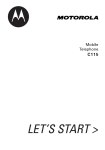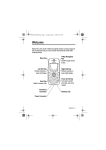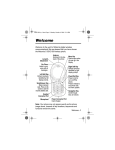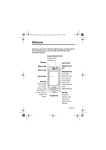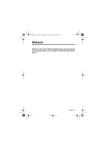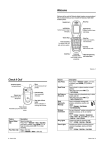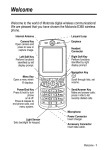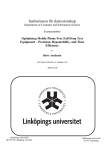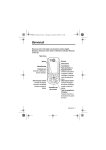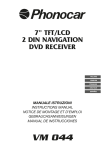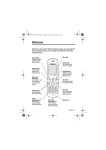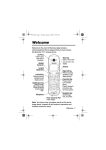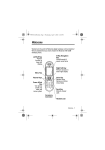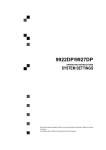Download Motorola C115 Specifications
Transcript
C115.CG.book Page 1 Friday, June 25, 2004 3:23 PM Welcome . Antenna Enclosed on the topback of the phone. Ear Piece Listen to your voice calls and messages. Right Soft Key Perform functions identified by right display prompt. Left Soft Key Perform functions identified by left display prompt. Power/End Key Press & hold to turn on/off the phone. Press & release to end phone calls, exit menu system. Send/Answer Key Make and answer calls. Press in idle screen to see the recent dialled calls. Navigation Key Scroll through lists, set volume. Headset Connector Port Microphone Menu Key Open a menu when you see in the display. Power Connector Port Insert charger. Note: Your phone may not appear exactly as the phone image above, however all key locations, sequences, and functions remain the same. Welcome - 1 C115.CG.book Page 2 Friday, June 25, 2004 3:23 PM www.motorola.com MOTOROLA and the Stylised M Logo are registered in the US Patent & Trademark Office. The Bluetooth trademarks are owned by their proprietor and used by Motorola, Inc. under licence. All other product or service names are the property of their respective owners. © Motorola, Inc. 2004 Caution: Changes or modifications made in the radio phone, not expressly approved by Motorola, will void the user’s authority to operate the equipment. Software Copyright Notice The Motorola products described in this manual may include copyrighted Motorola and third-party software stored in semiconductor memories or other media. Laws in the United States and other countries preserve for Motorola and third-party software providers certain exclusive rights for copyrighted software, such as the exclusive rights to distribute or reproduce the copyrighted software. Accordingly, any copyrighted software contained in the Motorola products may not be modified, reverse-engineered, distributed, or reproduced in any manner to the extent allowed by law. Furthermore, the purchase of the Motorola products shall not be deemed to grant either directly or by implication, estoppel, or otherwise, any licence under the copyrights, patents, or patent applications of Motorola or any third-party software provider, except for the normal, non-exclusive, royalty-free licence to use that arises by operation of law in the sale of a product. While Products specifications and features may be subject to change without notice, we are making every possible effort to ensure that user manuals are updated on a regular basis to reflect product functionality revisions. However, in the unlikely event that your manual version does not fully reflect the core functionality of your product, please let us know.You may also be able to access up-to-date versions of our manuals in the consumer section of our Motorola web site, at http://www.motorola.com. 2 - Welcome C115.CG.book Page 3 Friday, June 25, 2004 3:23 PM Contents Safety and General Information . . . . . . . . . . . . . . . . . . . . . . . . . 8 Getting Started. . . . . . . . . . . . . . . . . . . . . . . . . . . . . . . . . . . . . .15 Package Content . . . . . . . . . . . . . . . . . . . . . . . . . . . . . . . . . . .15 About This Manual. . . . . . . . . . . . . . . . . . . . . . . . . . . . . . . . . .15 Changing Your SIM Card and Battery . . . . . . . . . . . . . . . . . . .16 Charging Your Phone . . . . . . . . . . . . . . . . . . . . . . . . . . . . . . .16 Turning On/Off Your Phone . . . . . . . . . . . . . . . . . . . . . . . . . . .16 Learning to Use Your Phone. . . . . . . . . . . . . . . . . . . . . . . . . . .17 Adjusting the Volume . . . . . . . . . . . . . . . . . . . . . . . . . . . . . . . .17 Making and Answering Calls . . . . . . . . . . . . . . . . . . . . . . . . . .17 Symbols on the Screen . . . . . . . . . . . . . . . . . . . . . . . . . . . . . .18 Using the Menu . . . . . . . . . . . . . . . . . . . . . . . . . . . . . . . . . . . .19 Setting Up Your Phone . . . . . . . . . . . . . . . . . . . . . . . . . . . . . .20 Entering Text . . . . . . . . . . . . . . . . . . . . . . . . . . . . . . . . . . . . . .23 Calling Features. . . . . . . . . . . . . . . . . . . . . . . . . . . . . . . . . . . . 2. 6 Displaying Your Phone Number. . . . . . . . . . . . . . . . . . . . . . . .26 Redialling a Number . . . . . . . . . . . . . . . . . . . . . . . . . . . . . . . .26 Using My Caller ID. . . . . . . . . . . . . . . . . . . . . . . . . . . . . . . . . .27 Terminating an Incoming Call . . . . . . . . . . . . . . . . . . . . . . . . .27 Dialling an Emergency Number . . . . . . . . . . . . . . . . . . . . . . . .27 Dialling International Numbers. . . . . . . . . . . . . . . . . . . . . . . . .28 Inserting Special Characters into Dialling Sequences . . . . . . .28 Viewing the Received Calls or Dialled Calls List . . . . . . . . . . .29 Returning an Unanswered Call . . . . . . . . . . . . . . . . . . . . . . . .31 Entering Numbers in the Notepad . . . . . . . . . . . . . . . . . . . . . .31 Attaching a Number . . . . . . . . . . . . . . . . . . . . . . . . . . . . . . . . .32 Contents - 3 C115.CG.book Page 4 Friday, June 25, 2004 3:23 PM Using Voicemail . . . . . . . . . . . . . . . . . . . . . . . . . . . . . . . . . . . .32 Speed Dialling . . . . . . . . . . . . . . . . . . . . . . . . . . . . . . . . . . . . .33 One-Touch Dialling . . . . . . . . . . . . . . . . . . . . . . . . . . . . . . . . .34 Quick Dialling. . . . . . . . . . . . . . . . . . . . . . . . . . . . . . . . . . . . . .34 Using Call Waiting . . . . . . . . . . . . . . . . . . . . . . . . . . . . . . . . . .35 Diverting a Call . . . . . . . . . . . . . . . . . . . . . . . . . . . . . . . . . . . .36 Conference Calls . . . . . . . . . . . . . . . . . . . . . . . . . . . . . . . . . . . 38 Barring a Call. . . . . . . . . . . . . . . . . . . . . . . . . . . . . . . . . . . . . .38 Putting a Call on Hold . . . . . . . . . . . . . . . . . . . . . . . . . . . . . . .39 Lock/Unlock the Keypad . . . . . . . . . . . . . . . . . . . . . . . . . . . . .39 Messages . . . . . . . . . . . . . . . . . . . . . . . . . . . . . . . . . . . . . . . . . .40 Sending Messages . . . . . . . . . . . . . . . . . . . . . . . . . . . . . . . . .40 Viewing Message Status . . . . . . . . . . . . . . . . . . . . . . . . . . . . .41 Receiving and Reading Messages . . . . . . . . . . . . . . . . . . . . .42 Replying to Messages . . . . . . . . . . . . . . . . . . . . . . . . . . . . . . .42 Locking or Deleting a Text Message . . . . . . . . . . . . . . . . . . . .43 Phonebook . . . . . . . . . . . . . . . . . . . . . . . . . . . . . . . . . . . . . . . . .44 Storing a Phonebook Entry . . . . . . . . . . . . . . . . . . . . . . . . . . .44 Dialling a Phonebook Entry . . . . . . . . . . . . . . . . . . . . . . . . . . .45 Editing a Phonebook Entry . . . . . . . . . . . . . . . . . . . . . . . . . . .46 Sorting and Copying Phonebook Entries. . . . . . . . . . . . . . . . .47 Checking Capacity. . . . . . . . . . . . . . . . . . . . . . . . . . . . . . . . . .48 Personalising Your Phone . . . . . . . . . . . . . . . . . . . . . . . . . . . .49 Customising Menus . . . . . . . . . . . . . . . . . . . . . . . . . . . . . . . . .49 Redefining Soft Keys . . . . . . . . . . . . . . . . . . . . . . . . . . . . . . . .49 Selecting a Different Language . . . . . . . . . . . . . . . . . . . . . . . .50 Using MyMenu. . . . . . . . . . . . . . . . . . . . . . . . . . . . . . . . . . . . .50 Getting More Out of Your Phone . . . . . . . . . . . . . . . . . . . . . . .52 Dialling Options . . . . . . . . . . . . . . . . . . . . . . . . . . . . . . . . . . . .52 4 - Contents C115.CG.book Page 5 Friday, June 25, 2004 3:23 PM Managing Your Calls . . . . . . . . . . . . . . . . . . . . . . . . . . . . . . . .53 Monitoring Phone Use . . . . . . . . . . . . . . . . . . . . . . . . . . . . . . .54 Network Features . . . . . . . . . . . . . . . . . . . . . . . . . . . . . . . . . .56 Personal Organiser Features . . . . . . . . . . . . . . . . . . . . . . . . . .57 Alarm Clock . . . . . . . . . . . . . . . . . . . . . . . . . . . . . . . . . . . . . . .57 Calculator. . . . . . . . . . . . . . . . . . . . . . . . . . . . . . . . . . . . . . . . .58 Converting Currency . . . . . . . . . . . . . . . . . . . . . . . . . . . . . . . .58 Security . . . . . . . . . . . . . . . . . . . . . . . . . . . . . . . . . . . . . . . . . . .59 Locking and Unlocking Your Phone. . . . . . . . . . . . . . . . . . . . .59 Changing Your Unlock Code . . . . . . . . . . . . . . . . . . . . . . . . . .60 Protecting the SIM Card . . . . . . . . . . . . . . . . . . . . . . . . . . . . .61 Games. . . . . . . . . . . . . . . . . . . . . . . . . . . . . . . . . . . . . . . . . . . . .62 Troubleshooting. . . . . . . . . . . . . . . . . . . . . . . . . . . . . . . . . . . . 6. 3 Specific Absorption Rate Data . . . . . . . . . . . . . . . . . . . . . . . . .68 Contents - 5 C115.CG.book Page 6 Friday, June 25, 2004 3:23 PM Menu Map Main Menu • • • • • • • • • • Messages Phonebook Recent Calls Games MyMenu Ring Styles Alarm Clock Settings More Quick Dial Note: The Main Menu above represents the standard phone menu layout. You or your service provider may have changed the order of the menu layout or changed the feature names. Not all features may be available for all users. 6 - Menu Map Shortcut In idle, press up or down to open phonebook, right or left to adjust volume. Go to : press Exit the menu system: press . . C115.CG.book Page 7 Friday, June 25, 2004 3:23 PM Settings Menu • • • • Call Divert * • Voice Call • Cancel All • Divert Status Phone Status • M y Tel. Num bers * • Active Line • Battery Meter In-Call Setup • In-Call Tim er • Call Cost Setup * • M y Caller ID • Answer Options • Call Waiting • Auto Redial Security • Phone Lock • Lock Keypad • Fixed Dial • Call Barring * • SIM PIN • New Passwords • Other Settings* • Personalise • M ain Menu • Keys • Greeting * • Quick Dial * • Initial Setup • Tim e and Date • Power On/Off • 1-Touch Dial • Backlight • Scroll • Animation • Language • Battery Save • Contrast • DTM F • M aster Reset • Network • New Network • Network Setup • Avail. Networks • M y Network List • Service Tone • Call Drop Tone • Band Selection • Headset • Auto Answer * Optional Network, SIM card, or subscription-dependent features. Menu Map - 7 C115.CG.book Page 8 Friday, June 25, 2004 3:23 PM Safety and General Information IMPORTANT INFORMATION ON SAFE AND EFFICIENT OPERATION. READ THIS INFORMATION BEFORE USING YOUR PHONE. The information provided in this document supersedes the general safety information in user guides published prior to December 1, 2002. Exposure To Radio Frequency (RF) Energy Your phone contains a transmitter and a receiver. When it is ON, it receives and transmits RF energy. When you communicate with your phone, the system handling your call controls the power level at which your phone transmits. Your Motorola phone is designed to comply with local regulatory requirements in your country concerning exposure of human beings to RF energy. Operational Precautions To assure optimal phone performance and make sure human exposure to RF energy is within the guidelines set forth in the relevant standards, always adhere to the following procedures. External Antenna Care Use only the supplied or Motorola-approved replacement antenna. Unauthorised antennas, modifications, or attachments could damage the phone. Do NOT hold the external antenna when the phone is IN USE. Holding the external antenna affects call quality and may cause the phone to operate at a higher power level than needed. In addition, use of unauthorised antennas may result in non-compliance with the local regulatory requirements in your country. 8 - Safety and General Information C115.CG.book Page 9 Friday, June 25, 2004 3:23 PM Phone Operation When placing or receiving a phone call, hold your phone as you would a wireline telephone. Body-Worn Operation To maintain compliance with RF energy exposure guidelines, if you wear a phone on your body when transmitting, always place the phone in a Motorola-supplied or approved clip, holder, holster, case, or body harness for this phone, if available. Use of accessories not approved by Motorola may exceed RF energy exposure guidelines. If you do not use one of the body-worn accessories approved or supplied by Motorola, and are not using the phone held in the normal use position, ensure the phone and its antenna are at least 1 inch (2.5 centimetres) from your body when transmitting. Data Operation When using any data feature of the phone, with or without an accessory cable, position the phone and its antenna at least 1 inch (2.5 centimetres) from your body. Approved Accessories Use of accessories not approved by Motorola, including but not limited to batteries and antenna, may cause your phone to exceed RF energy exposure guidelines. For a list of approved Motorola accessories, visit our website at www.Motorola.com. RF Energy Interference/Compatibility Note: Nearly every electronic device is susceptible to RF energy interference from external sources if inadequately shielded, designed, or otherwise configured for RF energy compatibility. In some circumstances your phone may cause interference. Safety and General Information - 9 C115.CG.book Page 10 Friday, June 25, 2004 3:23 PM Facilities Turn off your phone in any facility where posted notices instruct you to do so. These facilities may include hospitals or health care facilities that may be using equipment that is sensitive to external RF energy. Aircraft When instructed to do so, turn off your phone when on board an aircraft. Any use of a phone must be in accordance with applicable regulations per airline crew instructions. Medical Devices Pacemakers Pacemaker manufacturers recommend that a minimum separation of 6 inches (15 centimetres) be maintained between a handheld wireless phone and a pacemaker. Persons with pacemakers should: • ALWAYS keep the phone more than 6 inches (15 centimetres) from your pacemaker when the phone is turned ON. • NOT carry the phone in the breast pocket. • Use the ear opposite the pacemaker to minimise the potential for interference. • Turn OFF the phone immediately if you have any reason to suspect that interference is taking place. Hearing Aids Some digital wireless phones may interfere with some hearing aids. In the event of such interference, you may want to consult your hearing aid manufacturer to discuss alternatives. Other Medical Devices If you use any other personal medical device, consult the manufacturer of your device to determine if it is adequately shielded from RF energy. Your GP may be able to assist you in obtaining this information. 10 - Safety and General Information C115.CG.book Page 11 Friday, June 25, 2004 3:23 PM Use While Driving Check the laws and regulations on the use of phones in the area where you drive. Always obey them. When using your phone while driving, please: • Give full attention to driving and to the road. • Use hands-free operation, if available. • Pull off the road and park before making or answering a call if driving conditions so require. Operational Warnings For Vehicles With an Air Bag Do not place a phone in the area over an air bag or in the air bag deployment area. Air bags inflate with great force. If a phone is placed in the air bag deployment area and the air bag inflates, the phone may be propelled with great force and cause serious injury to occupants of the vehicle. Potentially Explosive Atmospheres Turn off your phone prior to entering any area with a potentially explosive atmosphere, unless it is a phone type especially qualified for use in such areas and certified as “Intrinsically Safe.” Do not remove, install, or charge batteries in such areas. Sparks in a potentially explosive atmosphere can cause an explosion or fire resulting in bodily injury or even death. Note: The areas with potentially explosive atmospheres referred to above include fuelling areas such as below decks on boats, fuel or chemical transfer or storage facilities, areas where the air contains chemicals or particles, such as grain, dust, or metal powders. Areas with potentially explosive atmospheres are often but not always posted. Safety and General Information - 11 C115.CG.book Page 12 Friday, June 25, 2004 3:23 PM Blasting Caps and Areas To avoid possible interference with blasting operations, turn OFF your phone when you are near electrical blasting caps, in a blasting area, or in areas posted “Turn off electronic devices.” Obey all signs and instructions. Batteries Batteries can cause property damage and/or bodily injury such as burns if a conductive material such as jewellery, keys, or beaded chains touch exposed terminals. The conductive material may complete an electrical circuit (short circuit) and become quite hot. Exercise care in handling any charged battery, particularly when placing it inside a pocket, bag, or other container with metal objects. Use only Motorola original batteries and chargers. Your battery or phone may contain symbols, defined as follows: Symbol LiIon BATT Definition Important safety information will follow. Your battery or phone should not be disposed of in a fire. Your battery or phone may require recycling in accordance with local laws. Contact your local regulatory authorities for more information. Your battery or phone should not be thrown in the trash. Your phone contains an internal lithium ion battery. Seizures/Blackouts Some people may be susceptible to epileptic seizures or blackouts when exposed to blinking lights, such as when watching television 12 - Safety and General Information C115.CG.book Page 13 Friday, June 25, 2004 3:23 PM or playing video games. These seizures or blackouts may occur even if a person never had a previous seizure or blackout. If you have experienced seizures or blackouts, or if you have a family history of such occurrences, please consult with your doctor before playing video games on your phone or enabling a blinkinglights feature on your phone. (The blinking-light feature is not available on all products.) Parents should monitor their children's use of video game or other features that incorporate blinking lights on the phones. All persons should discontinue use and consult a doctor if any of the following symptoms occur: convulsion, eye or muscle twitching, loss of awareness, involuntary movements, or disorientation. To limit the likelihood of such symptoms, please take the following safety precautions: • Do not play or use a blinking-lights feature if you are tired or need sleep. • Take a minimum of a 15-minute break hourly. • Play in a room in which all lights are on. • Play at the farthest distance possible from the screen. Repetitive Motion Injuries When you play games on your phone, you may experience occasional discomfort in your hands, arms, shoulders, neck, or other parts of your body. Follow these instructions to avoid problems such as tendonitis, carpal tunnel syndrome, or other musculoskeletal disorders: • Take a minimum 15-minute break every hour of game playing. • If your hands, wrists, or arms become tired or sore while playing, stop and rest for several hours before playing again. • If you continue to have sore hands, wrists, or arms during or after play, stop playing and see a doctor. Safety and General Information - 13 C115.CG.book Page 14 Friday, June 25, 2004 3:23 PM European Union Directives Conformance Statement Hereby, Motorola declares that this product is in compliance with • The essential requirements and other relevant provisions of Directive 1999/5/EC • All other relevant EU Directives IMEI: 350034/40/394721/9 0168 Type: MC2-41H14 Product Approval Number The above gives an example of a typical Product Approval Number. You can view your product's Declaration of Conformity (DoC) to Directive 1999/5/EC (the R&TTE Directive) at www.motorola.com/ rtte - to find your DoC, enter the product Approval Number from your product's label in the "Search" bar on the Web site 14 - Safety and General Information C115.CG.book Page 15 Friday, June 25, 2004 3:23 PM Getting Started Package Content Your wireless phone comes with a replaceable internal battery and is typically equipped with a charger. Other accessory may customise your phone to its maximum performance and portability. About This Manual Optional Features Features marked with this label are optional network, SIM card, and/or subscription-dependent features. All service providers in all geographical areas may not offer these features. Contact your service provider for information about availability. Optional Accessories Features marked with this label require the use of an optional Motorola Original™ accessory. Getting Started - 15 C115.CG.book Page 16 Friday, June 25, 2004 3:23 PM Changing Your SIM Card and Battery Your SIM (Subscriber Identity Module) card contains your phone number, service details and phonebook/message memory. It must be installed in your phone by placing it in the defined SIM card slot on your phone (located on the back of your phone underneath the replaceable battery). Charging Your Phone Before using the phone, you need to charge the battery. To ensure better performance of the battery, you should perform several full charge/discharge cycles. To charge your phone, you may plug the travel charger into the right jack on the bottom of your phone. Plug the other end of the travel charger into the appropriate electrical outlet. After the phone is fully charged with a display of Battery Full, you may remove the charger. Turning On/Off Your Phone To turn on/off your phone, press and hold power/end key . If necessary, enter your SIM card PIN code and press OK. (Note that after you enter an incorrect code 3 times, your SIM card is disabled and the phone displays . If necessary, enter your 4-digit code and press to unlock your phone. (Note that the default unlock code is set to 1234.) 16 - Getting Started C115.CG.book Page 17 Friday, June 25, 2004 3:23 PM Learning to Use Your Phone Adjusting the Volume When you are in a call, adjust the earpiece speaker volume by pressing left or right on the Navigation Key . When the phone display is in idle, press the navigation key right or left to adjust ring volume. By pressing to the very left, you may mute the phone or turn the phone to the vibrate mode. Making and Answering Calls To make a call, you may enter the number with keypad keys. (Press to erase the last digit, or hold to erase all digits.) You may press Send key to make the call and End key when the call is done.To make a call from the phonebook, see Phonebook on Page 44. To answer a call, press the Send/Answer key to receive a call (or you may apply the any key answer function). To end the call, press the Power/End key . Find the Feature > > > > Learning to Use Your Phone - 17 C115.CG.book Page 18 Friday, June 25, 2004 3:23 PM Symbols on the Screen o Signal Strength Indicator p In use Indicator q Roam Indicator r Message Indicator ] Battery Level Indicator n Alert Type Indicator ^ Clock _ Menu Indicator n Alert Type Indicator shows the current selected alert profile. The default alert setting is loud ring. o Signal Strength Indicator shows the strength of your phone's connection with the network. p In use Indicator indicates when a call is in progress, and when you have a secure or insecure connection. q Roam Indicator appears when your phone uses another network system outside your home network. Icon here can also indicate your text entry mode, alpha, numeric, symbol and etc. r Message Indicator appears when you have a new voice or text message waiting. ] Battery Level Indicator shows the amount of charge left in your battery. The more the bars, the greater the charge. ^ Clock displays the real time. See page 20 for setting the Time and Date. _ Menu Indicator indicates that you may press Main Menu to open the system menu. 18 - Learning to Use Your Phone C115.CG.book Page 19 Friday, June 25, 2004 3:23 PM Using the Menu Navigating to a Feature To access many of your phone's features, you may use these keys to move through the menu system: Right Soft Key Press to apply the function indicated on the bottom right of the screen. Left Soft Key Press to apply the function indicated on the bottom left of the screen. Send/Answer Key Make and answer calls, and view recent dialled calls. Power/ End Key Press & hold to turn on/off the phone. Or press to end calls and exit menus. Navigation Key Scroll through menus/lists, and set feature values. The following example demonstrates how to select a feature and enter information: Find the Feature > ! > Press and scroll to !, and select to see the detailed call list. Selecting a Feature You may need to select a feature from a list. Some features require you to select an item from a list, and you may: Press to go back to the previous screen. Scroll up or down through the items. Press " to see the details of the highlighted item. Or press again to enter the available sub-menu. Learning to Use Your Phone - 19 C115.CG.book Page 20 Friday, June 25, 2004 3:23 PM Entering Feature Information Features such as #$% and require you to enter detailed information. Press to exit the menu without making changes. Note: appears when you enter information. Press it to save the information. Press $ to edit the selected item. Also, you may scroll up or down through the numeric items. • Enter numbers or text with the keypad. • When an item contains values, press or right and select the value. or to scroll left Setting Up Your Phone A variety of phone settings are offered to suit your needs. Setting the Time and Date Find the Feature > > $ > & > ' Changing Personal Greetings Find the Feature 20 - Learning to Use Your Phone > > $ > # > C115.CG.book Page 21 Friday, June 25, 2004 3:23 PM Choosing Alert and Ring Tones Your phone rings and/or vibrates to notify you of an incoming call, message, or other event. This ring or vibration is called an alert. You can select one of five different alert profiles: (&!, )!, "%, !*"%, and . Each alert profile contains settings for ringer and keypad volume. It also includes alert tone settings for different events: incoming calls, text messages, voicemail messages, alarms, and reminders. You can modify the setting in each profile. To choose alert profile: Find the Feature > ! > desired profile > )' To customise your alert profile, your phone notifies you of specific events: Find the Feature > ! > desired event > )' > alert for event > )' Setting Backlight To set the time span that the display backlight lasts: Find the Feature > > $ > & > $ Learning to Use Your Phone - 21 C115.CG.book Page 22 Friday, June 25, 2004 3:23 PM Setting Contrast To set the amount of contrast of your display: Find the Feature > > $ > & > Setting Display Scrolling To set the cursor to either stop or wrap around when it reaches the top or end of a list: Find the Feature > > $ > & > Setting Display Animation To turn on/off the animation (to conserve the battery): Find the Feature > > $ > & > ' Setting Battery Save To conserve the phone's power usage: Find the Feature 22 - Learning to Use Your Phone > > $ > & > + C115.CG.book Page 23 Friday, June 25, 2004 3:23 PM Resetting all Options To restore all options to factory default values, except for unlock code, security code, and lifetime timer: Find the Feature > > $ > & > ! Setting Up Your Phone for Optional Handsfree Use A phone headset enables you to use your phone without using your hands. This accessory provides an alternative way for you to use your phone without using your handset. Note: The use of wireless devices and their accessories may be prohibited or restricted in certain areas. Always obey the laws and regulations on the use of these products. Find the Feature > > $ > , > & Entering Text The default Tap Method makes it easy for you to enter names, numbers and text messages on your phone. You can enter all characters (letters, numbers, and symbols) using the standard tap method. To enter text with the tap method, press a number key 1 or more times to cycle through characters. Release the key to enter the displayed character. Press when you are finished editing. Learning to Use Your Phone - 23 C115.CG.book Page 24 Friday, June 25, 2004 3:23 PM To switch from iTAP mode to TAP mode in the languages available on your phone, press or and confirm the mode you would like to use. Character Chart Use this chart as a guide for entering spaces, numbers, letters, symbols, and other characters with the Tap Method text mode. Press the same key repeatedly to cycle through available characters. + - 0 x * / \ [ ] = > < # § . 1 ? ! , @ _ & ~ : ; " - ( ) ' ¿ ¡ % £ $ ¥ a b c 2 d e f 3 g h i 4 j k l 5 m n o 6 p q r s 7 t u v 8 w x y z 9 24 - Learning to Use Your Phone C115.CG.book Page 25 Friday, June 25, 2004 3:23 PM Capitalisation and Add a Space Press up or down or To change the words to initial character capitalised, all uppercase characters, or all lowercase characters change a single letter to uppercase. When a single letter is highlighted, you may press to capitalise that letter only. add a Space Delete Letters and Words Action Press to delete 1 letter at a time. Press and hold to delete the entire message. Note: Sizes of characters may vary from one language to another. Learning to Use Your Phone - 25 C115.CG.book Page 26 Friday, June 25, 2004 3:23 PM Calling Features This chapter describes features related to making and answering calls. Displaying Your Phone Number From the idle display: Action Press > > #$ & > -&'% to see your phone number. Your phone number must be programmed on your SIM card in order to use this feature. When you are on a call: Action Press > -&'% to see your phone number. Redialling a Number You can redial a previously dialled phone number, whether the call was connected or busy. From the idle display: Press To go directly to the dialled calls list > ! > !+, or scroll to the entry you want to call 1 2 3 26 - Calling Features redial the highlighted number C115.CG.book Page 27 Friday, June 25, 2004 3:23 PM Using My Caller ID The calling line identification (caller ID) feature lets you see who is calling before answering. If the caller’s name is stored in your phonebook, the phone automatically displays the '. Otherwise, the phone displays the caller's phone number. If caller ID information is not available, your phone displays ' . Terminating an Incoming Call While the phone is ringing or vibrating: Press or ! To cancel the incoming call Depending on your phone settings and the type of subscription you have, the call may be forwarded to another number, go directly to Voice Mail, or the caller may hear a busy signal. Dialling an Emergency Number Your service provider programs one or more emergency phone numbers (such as 999) that you can call under any circumstances. You can dial and call the emergency number even when your phone is locked, when you are prompted to enter a code or password, when the SIM card is not inserted in your phone, or when the SIM card is blocked or disabled. Note: Emergency numbers vary by country. Your phone's emergency number(s) may not work in all locations. Calling Features - 27 C115.CG.book Page 28 Friday, June 25, 2004 3:23 PM To call the emergency number at any time: Press 1 keypad keys 2 To dial the emergency number call the emergency number Dialling International Numbers To dial the local international access code: Action Press for 2 seconds to insert the international access code (.) prior to entering the country code and phone number that you want to dial. Inserting Special Characters into Dialling Sequences In addition to pressing numbers on your keypad, you can insert special characters in a phone number. While dialling (with digits visible in the display), you can press Main Menu to insert one of the following (by pressing two times, shows, three times, shows in the display): Option Description Insert Pause (insert a ) Your phone waits until the call connects before it dials the next digit(s) in the series. Insert Wait (insert a ) Your phone waits until the call connects, then prompts you for confirmation before it dials the next digit(s). 28 - Calling Features C115.CG.book Page 29 Friday, June 25, 2004 3:23 PM Viewing the Received Calls or Dialled Calls List Your phone keeps lists of the numbers from calls you recently received and dialled, even if the calls did not connect. The lists are sorted from newest to oldest entries. The oldest entries are deleted as new ones are added. Each entry tells you the person's number (or name, if available) and whether the call connected or not. You can call, store, or delete the numbers on these lists. Shortcut: Press to go directly to the dialled calls list from the idle display. To open the recent calls menu: Find the Feature Press 1 > ! 2 3 highlight entry > ! To scroll to !+ or select !+ or scroll to an entry you want to call, store, or delete Note: If an entry is in bold print, it means the call connected. Calling Features - 29 C115.CG.book Page 30 Friday, June 25, 2004 3:23 PM Press 4 To call the entry’s number Note: Press and hold for 2 seconds to send the entry number as DTMF tones. or or press " to see the entry's details or to save the entry's details in the phonebook or open the(& to perform other procedures as described in the following list The ( menu includes the following options: Option ,/ $ 30 - Calling Features Description Create a phonebook entry with the selected number in the No. field. (This option does not appear if appears above the keys, or if the number is already stored as a phone book entry.) Delete the entry. (This option does not appear if appears above the key.) Delete all entries in the current list. Hide or show your caller ID for the next call. C115.CG.book Page 31 Friday, June 25, 2004 3:23 PM Option $&'% Description Create a new text message, with the selected number in the - field. Add digits to the end of the selected number. Attach another number from the phonebook or recent calls list to the end of the selected number. Returning an Unanswered Call When powered On, your phone keeps a record of your unanswered calls. When you cannot answer a call, you phone displays the missed call indicator and the message of how many missed calls there were. Press 1 " 2 3 To see the received calls list, beginning with the most recent call scroll through the list and select a call that you want to return make the call Entering Numbers in the Notepad Your phone stores the most recent string of digits entered on the keypad in a temporary memory location called the notepad. These digits can be the last phone number that you called, or a phone number that you simply entered but did not call. These digits remain in the notepad even when you turn off the phone. Calling Features - 31 C115.CG.book Page 32 Friday, June 25, 2004 3:23 PM To call the number, create a phonebook entry, or perform other operations with the number stored in the notepad: Find the Feature Press > ! > To call the number or open the & (to attach a number or insert a special character) or create a new phonebook entry with the notepad number copied into the - field Attaching a Number You can attach a number from your phonebook or recent calls list to the digits you enter in the display. While dialling (with digits visible in the display): Action Press > $&'% to attach a number from the phonebook or recent calls list to the end of the digits you entered. Using Voicemail You can listen to your voicemail messages by calling your network voicemail phone number. Voicemail messages are stored on the network-not on your phone. Contact your service provider for more details. 32 - Calling Features C115.CG.book Page 33 Friday, June 25, 2004 3:23 PM Storing Your Voice Mail Number Store your voicemail number in your phone to make it faster and easier to use voicemail. Your voice mail number is provided by your service provider. Find the Feature Press 1 keypad keys 2 > > " To enter the phone number for your voicemail store the number Receiving a New Voicemail Message When you receive a voicemail message, your phone displays New VoiceMail notification message incoming and VoiceMail indicator on the status pane.(Some networks only indicate when you have messages, whether they are new or not.) If users delete all VoiceMail messages, the VoiceMail indicator will disappear. Listening to a Voicemail Message To listen to you voicemail message at any time: Find the Feature > > " Your phone calls the voicemail phone number you stored. If you do not have a voicemail number stored, the phone guides you through storing a number. Speed Dialling Speed dial lets you dial any phonebook entry with a minimal number of key presses. Calling Features - 33 C115.CG.book Page 34 Friday, June 25, 2004 3:23 PM When you store an entry in your phonebook, it is assigned a unique speed dial number. You can then use the speed dial feature to call the entry. In the idle display: Press 1 keypad keys 2 To enter the speed dial number for the entry you want to dial submit the number 3 call the entry One-Touch Dialling You can call phonebook entries 1 to 9 with the push of a single key. The first nine numbers from the SIM card would be put in the OneTouch Dialling locations of 1-9. Press and hold the 1-digit speed dial number for 1 second. Find the Feature > > $ > & > /0&$ Quick Dialling You can dial pre-programmed numbers stored on your phone. Your service provider may program your phone with one or more quick dial numbers, such as the customer service number. You can call them by selecting them from the quick dial list. Find the Feature > 1& Note: Your service provider may use a different name for this feature. 34 - Calling Features C115.CG.book Page 35 Friday, June 25, 2004 3:23 PM To change your quick dial numbers: Find the Feature > > $ > # > 1& Using Call Waiting If you subscribe to call waiting, an alert tone sounds while you are on a call to indicate that you have received a 2nd call. To put the 1st call on hold and answer the 2nd call, press SWITCH. To put the 1st call on hold and answer the 2nd call: Press 1 2 $ ( To answer the new call return to the 1st call Note: You can press $ at any time to switch between calls. To end the 1st call and answer the 2nd call: Press 1 To end the current call 2 Your phone rings to signal the new call. answer the new call Calling Features - 35 C115.CG.book Page 36 Friday, June 25, 2004 3:23 PM To activate or deactivate call waiting: Find the Feature > > 0 & > 2 Diverting a Call Call diverting sends your phone's incoming calls directly to another phone number. Use call diverting options to specify which calls your phone should divert. When you are ready to accept calls on your phone again, you can turn off call diverting. Set Up or Cancel Call Diverting Find the Feature > > + The Call Divert option include ", , and + &. 1 Press To scroll to the type of calls you want to divert 2 ( cancels all call diverting and ends the procedure.) open the call divert details for that call type scroll to + 3 4 $ 5 6 36 - Calling Features change the + option scroll to the call divert option you want store the option C115.CG.book Page 37 Friday, June 25, 2004 3:23 PM Press 7 8 $ 9 keypad keys To scroll to (same for )&, ) , or ) $%) change the phone number enter the diverting phone number or 10 browse through your phonebook or other lists for the diverting phone number store the diverting phone number Note: You can repeat this procedure to enter diverting information for other call types. Check Call Diverting Status Your network may store call diverting status for you. If you change your phone's call divert settings, then you should confirm that the network call divert status matches your preferences. Find the Feature Press 1 2 " > > + > + & To scroll to " confirm that the network settings are correct Calling Features - 37 C115.CG.book Page 38 Friday, June 25, 2004 3:23 PM Conference Calls To talk to more than 1 person on a call, you can make a conference call. Call the 1st person, call the 2nd person, then link the 2 calls. Press 1 keypad keys 2 3 , To dial the 1st person's number call the number put the 1st call on hold or > , 4 keypad keys 5 6 ( 7 Your phone displays a flashing phone indicator next to the call on hold. dial the next person’s number call the number Your phone displays an active call indicator next to the new active call. connect the 2 calls end the entire call Barring a Call Call barring lets you restrict outgoing or incoming calls. You can restrict all calls, calls to international numbers, or calls while roaming. Find the Feature 38 - Calling Features > > & > C115.CG.book Page 39 Friday, June 25, 2004 3:23 PM Press To scroll to & or ' calls 1 2 $ 3 4 5 keypad keys 6 select barring for & or ' calls scroll to a restriction for the barred calls select the restriction for the barred calls enter your call barring password (from your network service provider) submit your password Putting a Call on Hold When you are on a call: Action Press , (if available). or Press > ,. Your phone displays a "flashing phone" indicator to indicate that the call is on hold. Lock/Unlock the Keypad By pressing the Menu Key and then the mode, you may lock/unlock the keypad. key while in idle Calling Features - 39 C115.CG.book Page 40 Friday, June 25, 2004 3:23 PM Messages Text messages are brief messages that you can send and receive (such as 2$'3). Received messages appear on your pone display or in your text message inbox. You must set up the text message inbox before you can send and receive these messages. The total number of messages the inbox can hold depends on the length of the message, and the number of other messages and drafts stored in your phone. Note: Your service provider may have already programmed the text message inbox settings for you. Sending Messages You can send text messages to 1 or more recipients. You can manually enter the recipient's phone number, or select the number or numbers from the phonebook or recent calls lists. Shortcut: While dialling (with digits visible in the display), you can press > to create a text message addressed to the number entered. Find the Feature Press 1 $ 40 - Messages > > To select C115.CG.book Page 41 Friday, June 25, 2004 3:23 PM Press 2 keypad keys To enter one or more phone numbers where you want to send the message 6 7 select one or more phone numbers from the phonebook or recent calls lists store the number(s) select enter the text message Note: Message length is limited. When you're close to the limit, a twodigit display shows how many characters are left. store the text message finish the message 8 Your phone displays 3. send the message 3 4 $ 5 keypad keys or You can choose + or + &%4 Viewing Message Status Text messages that you send are stored in the Outbox. To view the content of your outbox: Find the Feature > > &%4 Text messages are sorted from the newest to oldest. Messages - 41 C115.CG.book Page 42 Friday, June 25, 2004 3:23 PM Receiving and Reading Messages Note: you must set up the text message inbox before you can receive text messages. When you receive a new message, your phone displays New Message and gives you an alert. Press ! to open the message (or your text message inbox if there are multiple messages). You can press to view the 4&, which includes the following options: Options 5 Description Open a copy of the text message, with an empty field. Save callback number. Replying to Messages While viewing a text message, you can create a reply: The 4 & includes the following: Options > ! 42 - Messages Description Open a new text message with the message's ! number in the field. C115.CG.book Page 43 Friday, June 25, 2004 3:23 PM Locking or Deleting a Text Message You can open your text message inbox to read, lock or delete messages at any time. Messages in the text message inbox are sorted from newest to oldest. If you want to save a message, you should lock it to prevent it from deleting. Find the Feature Press 1 2 ! 3 + > > 4 To scroll to the message you want: unread and urgent, read, read and locked messages open the message close the message without changes or delete the message or open the 4& Messages - 43 C115.CG.book Page 44 Friday, June 25, 2004 3:23 PM Phonebook You can store a list of names and phone numbers in your phone's electronic phonebook. You can view these entries and call them directly from your phone. To see the list of names stored in your phonebook, press > #$% from the idle display. Scroll to a name and press " to view details of the phonebook entry as shown in the following display. Storing a Phonebook Entry A phone number is required for a phonebook entry. All other information is optional. You can store a phonebook entry on your SIM card only. Shortcut: Enter a phone number in the idle display, then press to create a phonebook entry with the number in the - field. Go directly to step 3 in the following procedure to enter additional information and store the entry. Note: You can also use the following procedure to store a fixed dial entry by scrolling to and selecting 54- Enter Information Find the Feature Press 1 2 $ 3 keypad keys 44 - Phonebook > #$% > To select the type of entry select ' enter a name for the phonebook entry C115.CG.book Page 45 Friday, June 25, 2004 3:23 PM Press 4 5 keypad keys 6 7 8 $ 9 keypad keys 10 To store the name enter the phone number store the phone number scroll to -, the number., the number to speed dial the entry The next available speed dial number is assigned to a new phonebook number by default. select - if you want to change it enter a different speed number if desired save the modified speed number If your chosen speed number is already assigned to another entry, you are asked if you want to replace that entry. Complete Phonebook Entry When you finish entering information for a phonebook entry: Press To store the entry and return to the phonebook list Dialling a Phonebook Entry You can use the phonebook list, speed dial, or 1-touch dial to call a number stored in your phonebook. Phonebook - 45 C115.CG.book Page 46 Friday, June 25, 2004 3:23 PM Phonebook List Find the Feature Press > #$% To scroll to the entry you want call the entry Editing a Phonebook Entry You can edit a phonebook entry stored on your SIM card. If you change an entry's speed dial number, the entry is moved to the new speed dial location and the original entry is deleted. Note: You can also use the following procedure to edit a fixed dial entry by scrolling to and selecting 54. Find the Feature Press 1 2 " 3 > #$% To scroll to the entry you want to edit display the entry's detailed view edit the phonebook entry Deleting a Phonebook Entry Find the Feature Press 1 46 - Phonebook > #$% To scroll to the entry you want to delete C115.CG.book Page 47 Friday, June 25, 2004 3:23 PM Press 2 To open the phonebook menu 3 scroll to 6 5 select confirm the deletion Sorting and Copying Phonebook Entries You can copy 1 phonebook entry from your SIM card location to another SIM card location. Note: This function copies the original entry to a new location. It does not delete the original entry. Copy a Single Entry Find the Feature Press 1 2 3 4 keypad keys 5 > #$% To open the phonebook menu scroll to select edit the speed dial number approve the copy to the speed dial number The phone displays . You can now delete the old phone book entry, if desired. Phonebook - 47 C115.CG.book Page 48 Friday, June 25, 2004 3:23 PM Checking Capacity To check how much space is left in your phonebook, your phone displays a memory meter. To see how much memory is left in your SIM card, your phone lists the number of phonebook entries used and the number available. Press 1 2 3 To open the phonebook menu scroll to select Your phone displays the number of SIM card phonebook entries available. 48 - Phonebook C115.CG.book Page 49 Friday, June 25, 2004 3:23 PM Personalising Your Phone Customising Menus Your can customise the order of the items in your phone's main menu, depending upon your usage. Find the Feature Press 1 2 % 3 4 > > $ > # > & To scroll to the menu item you want to move grab the menu item you want to move move the item up or down the menu insert the item in the new location Redefining Soft Keys Find the Feature Press 1 2 $ 3 4 > > $ > # > To scroll to () or !$ open the key editor scroll to the new key function confirm the new function Personalising Your Phone - 49 C115.CG.book Page 50 Friday, June 25, 2004 3:23 PM Selecting a Different Language Find the Feature > > $ > & > (& Using MyMenu & enables you to quickly access your favourite menu features. It is a pre-programmed with shortcuts to several features, but you can add more. Using MyMenu Shortcut You can use & from the idle display, while on a call, or while scrolling through a menu. Use a MyMenu Key Number Press 1 2 the & key number To open the menu go to the menu item, or perform the menu action Select a Feature From the MyMenu list Find the Feature > & > desired feature Note: To edit or delete a & feature, highlight it in the list and press the menu key to open a menu of options for the feature. 50 - Personalising Your Phone C115.CG.book Page 51 Friday, June 25, 2004 3:23 PM Adding a MyMenu Shortcut 1 Press To enter the menu system 2 highlight the menu item 3 press and hold open the & editor 4 5 $ The phone displays &)7 "Item"3, where Item is the name of the item you selected. view your options change the & key number, if necessary or select the & key number and close the editor Personalising Your Phone - 51 C115.CG.book Page 52 Friday, June 25, 2004 3:23 PM Getting More Out of Your Phone Dialling Options Fixed Dialling When you activate the fixed dial feature, users can only call the number in the fixed dial list. Note: Employers can use fixed dial to limit employees' phones to a predefined list of numbers, country codes, or other prefixes. Activating Fixed Dial Find the Feature > > & > 54 Creating and Calling Fixed Dial Entries Fixed Dial list entries can be any length.You must enter your SIM PIN2 code, from your network service provider, to edit fixed dial entries. To open the fixed dial list: Find the Feature > > 54 In the fixed dial list, you can create, edit, delete, and sort entries just like in the phonebook list. Fixed dial list entries are stored on your SIM card. Service Dialling Dial preprogrammed numbers stored on your SIM card. Your Service provider can program your SIM card with phone numbers for services such as taxi companies, restaurants., and hospitals. Find the Feature 52 - Getting More Out of Your Phone > > + C115.CG.book Page 53 Friday, June 25, 2004 3:23 PM Managing Your Calls Calling a number in a Text Message If you receive a text message with an embedded phone number, you can dial the number directly. Find the Feature Press > > 4 1 To scroll to the ' with the number 2 open the 4 menu 3 4 scroll to dial the number in the message If the message contains more than 1 phone number, scroll to the desired number and press to dial. Sending DTMF Tones While you are on a call, you can send key presses as tones: Action Press > to send a number to the network as DTMF tones, for credit card calling or password entry. To set the tones to be Long DTMF or Short DTMF: Find the Feature > > $ > & > 5 Getting More Out of Your Phone - 53 C115.CG.book Page 54 Friday, June 25, 2004 3:23 PM Monitoring Phone Use Viewing and Resetting Call Timers Your phone tracks and records call times. Use the recent calls menu to view and reset a call timer. Network connection time is the elapsed time from the moment you connect to your service provider's network to the moment you end the call by pressing the key. This time includes busy signals and ringing. The amount of network connection time you track on your resettable timer may not be equal the amount of time for which you are billed by your service provider. For billing information, please contact your service provider directly. To view a call timer: Find the Feature Press 1 2 > ! > ' To scroll to the ' you want to view view the recorded time To reset call timer: Press 1 ! 2 To reset the time if available confirm the reset 54 - Getting More Out of Your Phone C115.CG.book Page 55 Friday, June 25, 2004 3:23 PM You can view the approximate network connection time elapsed during the following calls: Timer ( !+ ()' Description Time of the last call dialled or received. You cannot reset this timer. Total time of dialled calls since the last time you reset this timer. Total time spent on calls received since the last time you reset this timer. Total time of dialled and received calls since the last time you reset this timer. Total time of all calls on this phone. You cannot reset this timer. Viewing and Resetting Call Costs Find the Feature Press 1 2 > ! > To scroll to the cost tracker you want to view view the recorded cost To reset the call tracker: Press 1 ! 2 To reset the cost if available enter your PIN2 code to confirm the reset Getting More Out of Your Phone - 55 C115.CG.book Page 56 Friday, June 25, 2004 3:23 PM Network Features Your phone network can provide the following call cost information: Cost Tracker +% ( ! Description Amount of your credit remaining. For GSM advice-of-charge, this is only available if you set a credit limit. Note: your phone receives cost information from the adviceof-charge feature or third-party prepay software. Amount for the last call you dialled or received. You cannot reset this cost tracker. Amount for all dialled and received calls since the last time you reset this cost tracker. You can reset this value separate from and !+, so plus !+ may not equal . Reset all call cost records. Network Features Network Selection Find the Feature > > $ > Your service provider registers your phone to a network.You can view information about the current network, change how your phone searches for a network, specify your preferred networks, and activate alerts that indicate when a call is dropped or network registration changes. 56 - Getting More Out of Your Phone C115.CG.book Page 57 Friday, June 25, 2004 3:23 PM Personal Organiser Features Alarm Clock Find the Feature > ' Press To create/edit alarm item 1 > or 8 9 Alarm content list: '7 '7 2 > same as above 3 > delete 1 alarm item 4 > delete all alarm items Note: The alarm clock in your phone must be set while your phone is . You may then power your phone 55 to conserve your phone's battery. Although your phone is powered 55, the alarm clock will provide you with an audible alert at the time you have set in your phone. Personal Organiser Features - 57 C115.CG.book Page 58 Friday, June 25, 2004 3:23 PM Calculator Find the Feature > > & Press 1 number keys To enter a number in the calculator highlight a calculator function 2 3 perform the highlighted function Converting Currency Find the Feature Press 1 numberkeys 2 58 - Personal Organiser Features > > 4$! To enter the exchange rate store the exchange rate C115.CG.book Page 59 Friday, June 25, 2004 3:23 PM Security Locking and Unlocking Your Phone You can look your phone manually or set your phone to lock automatically whenever you turn it off. When you try to use a locked phone, it asks you to enter the unlock code. A locked phone still rings or vibrates for incoming calls or messages, but you must unlock it to answer. You can make emergency call on your phone even when it is locked. Lock your Phone Manually Find the Feature Press 1 keypad keys 2 > > & > #$( > ( To enter your 4-digit unlock code lock the phone Set Your Phone to Lock Automatically Find the Feature Press 1 keypad keys 2 > > & > #$( > &'( > To enter your 4-digit unlock code set the phone to lock automatically Security - 59 C115.CG.book Page 60 Friday, June 25, 2004 3:23 PM Unlock Your Phone Press 1 keypad keys To enter your 4-digit unlock code 2 The unlock code is originally set to 1234. unlock your phone Changing Your Unlock Code Find the Feature Press 3 4 5 6 7 8 9 $ keypad keys keypad Keys keypad keys > > & > # To scroll to the code or password you want to change select the or enter your old code submit your old code enter the new code assign the new code re-enter the new code confirm the new code If you forget a code or password Press 1 60 - Security To go to the unlock code bypass screen C115.CG.book Page 61 Friday, June 25, 2004 3:23 PM Press 2 keypad keys 3 To enter your security code submit your security code Protecting the SIM Card Find the Feature > > & > # Unlock the SIM card PIN Code Press 1 2 3 4 5 6 7 keypad keys keypad keys keypad keys To open the PIN unblocking editor enter the PIN code submit the PIN code enter a new SIM card PIN code assign the new SIM PIN code re-enter your SIM card PIN code confirm the new SIM PIN code and unblock the SIM card Security - 61 C115.CG.book Page 62 Friday, June 25, 2004 3:23 PM Games Your phone comes with three games. If you get an incoming call, message, alarm or alert, the game ends automatically. Find the Feature Press 1 > 2 > ' To scroll to the game of your choice start the game To end a game at any time: Press : 62 - Games To end the game session or return to the game menu C115.CG.book Page 63 Friday, June 25, 2004 3:23 PM Troubleshooting Check these questions first if you have problems with your phone: Question How do I know if my battery is charged? Do you have a valid SIM card inserted in your phone? Does the handset have a signal? Do you see a signal showing in the display? Is the earpiece volume too low? Is the other party unable to hear you? Answer The battery level indicator should show at least one bar (segment) of power. If it does not, please recharge your phone’s battery. (See “Changing Your Phone” on Page 16.) If the battery level indicator has three bars showing, then your phone’s battery is fully charged. If necessary, turn off your phone and make sure that you have inserted a valid SIM card. The signal strength indicator should have at least one segment showing. If it does not, move to an area with a stronger signal to use your phone. While on a call, scroll up. Your phone may be muted. You may take the call off of mute by making the appropriate soft key selection. (See page 17, Adjusting the Volume.) Also, you and/or the person you are speaking with may be in a weak network coverage area. Make sure that your phone's microphone is not obstructed. Troubleshooting - 63 C115.CG.book Page 64 Friday, June 25, 2004 3:23 PM Question Has the phone been damaged, dropped or got wet? I can't hear my phone ring. Answer Dropping your phone, getting it wet, or using a non-Motorola battery charger can damage the phone. The phone's limited warranty does not cover liquid damage or damage caused from using non-Motorola accessories. Ensure that your phone is not set to Silent or Vibrate. See page 20 on how do modify your phone's Alert and Ring Tone profiles: Loud, Soft Ring, Vibrate, Ring & Vibrate, and Silent. The following referring to specific problems: Problem My phone was stolen. To whom should I report this? I forgot my password I pressed the End/ Power key, but nothing happened. 64 - Troubleshooting Solution Report a stolen phone to the police and to your service provider. See “Changing Your Unlock Code” on page 60. To either turn your phone On or Off, you must Press and Hold the End/ Power Key for a couple of seconds. If your phone will still not turn On when you do this, then check to see if your phone's battery is charged. C115.CG.book Page 65 Friday, June 25, 2004 3:23 PM Problem The Display says Solution The SIM card may be incorrectly inserted. $ Check the SIM card to make sure that it is even inserted properly. If you changed the though I have default unlock code in your phone, please inserted my SIM enter the unlock code that you defined to card in the phone. unlock it. Call your service provider to obtain the PIN The display says . unblocking code. How do I unblock If you changed the default unlock code in my SIM card? your phone, please enter the unlock code that you defined to unlock it. The display says Enter the factory-preset unlock code, . 1234, or the last 4 digits of your phone How do I unlock number. my phone? My phone asks for The application you want is locked. If you an unlock code own the phone but do not know the unlock when I try to open code, see “Changing Your Unlock Code” a feature. on page 60. The ringer may be set to play a tone even My phone rings even though I though your phone is set to a silent alert selected the silent profile. or vibrate alert profile. I tried to place a Your call did not reach the wireless call and heard an system. You may have dialled the number alternating high/ too soon after turning the phone on. Wait low tone. until the display shows the name of your service provider before making a call. Troubleshooting - 65 C115.CG.book Page 66 Friday, June 25, 2004 3:23 PM Problem I cannot make/ answer calls. My phone has poor reception and drops calls. I cannot hear others on my phone. I cannot open my inbox. How do I see the calls I sent or received? 66 - Troubleshooting Solution Make sure that you have a phone signal. Avoid electrical or radio interference, and obstructions such as bridges, car parks, or tall buildings. Your phone may also have the Call Barring feature turned on. If you know the unlock code, you can change this setting in the security menu. > > &. Also, check and make sure your SIM card is inserted and working. Make sure you have a phone signal. Stay clear of any obstructions such as bridges, car parks, or tall buildings. While on a call, adjust the volume by scrolling with the Navigation Key to either the right (to increase) or to the left (to decrease) the phone volume in my earpiece. Also, make sure that your phone's earpiece is not blocked by its carrying case. Before you can use text or information services messages, you must set up the appropriate inbox. To see the most recent calls you dialled or received, open the list: > ! > !+ or . C115.CG.book Page 67 Friday, June 25, 2004 3:23 PM Problem My phone will not dial voicemail commands, passwords, or other codes. Solution Your phone sends commands and passwords as DTMF tones. You can set your phone's DTMF tones to be Long, Short or Off. If you have trouble sending numbers, check your DTMF setting. From the idle display, press: > > $ > & > 5. My phone's display is too light. What can I do to extend battery life? How do I remove the battery? My phone is stuck and none of the buttons I push will do anything. How do I make my phone work? Press to scroll to (5or $5 and press to confirm. You can change the level of contrast in your phone display. Your battery's performance is affected by charge time, feature use, temperature changes, and other factors. You may also select Battery Save to help maximise the amount of time that your battery will last between charges (see Setting Battery Save on page 22). Remove it by opening the back cover of the phone. You may need to reset your phone. To reset your phone (without changing any of the defaults that you currently have), remove your replaceable battery from your phone and then insert it back into your phone. This will reset your phone and you should be able to power your phone back on and use it again. Troubleshooting - 67 C115.CG.book Page 68 Friday, June 25, 2004 3:23 PM Specific Absorption Rate Data This model phone meets international standards for exposure to radio waves Your mobile phone is a radio transmitter and receiver. It is designed and manufactured not to exceed limits for exposure to radio frequency (RF) energy. These limits are part of comprehensive guidelines and establish permitted levels of RF energy for the general population. The guidelines are based on standards that were developed by independent scientific organisations through periodic and thorough evaluation of scientific studies. The guidelines include a substantial safety margin designed to assure the safety of all persons, regardless of age and health. The exposure standard for mobile phones employs a unit of measurement known as the Specific Absorption Rate, or SAR. Under the guidelines for your phone model, the SAR limit is 2.0 W/kg.1 Tests for SAR are conducted in accordance with CENELEC2 testing procedures using standard operating positions with the phone transmitting at its highest certified power level in all tested frequency bands. Although the SAR is determined at the highest certified power level, the actual SAR of the phone while operating can be well below the maximum value. This is because the phone is designed to operate at multiple power levels so as to use only the power required to reach the network. In general, the closer you are to a base station, the lower the power output of the phone. Before a phone model is available for sale to the public, it is tested to confirm compliance with the guidelines. The tests are performed in positions that conform to a uniform testing methodology determined by an expert standards body. The highest SAR value for this model phone when tested for use at the ear is: 0.88 W/kg.3 68 - Specific Absorption Rate Data C115.CG.book Page 69 Friday, June 25, 2004 3:23 PM While there may be differences between the SAR levels of various phones and at various positions, they all meet the governmental requirements for safe exposure. Please note that improvements to this product model could cause differences in the SAR value for later products; in all cases, products are designed to be within the guidelines. 1 The SAR limit recom m ended by international guidelines (ICNIRP) for m obile phones used by the public is 2.0 watts/kilogram (W /kg) averaged over ten gram s of tissue. The lim it incorporates a substantial m argin for safety to give additional protection for the public and to account for any variations in m easurem ents. 2 CENELEC is a European Union standards body. 3 Additional related inform ation includes the M otorola testing protocol, assessm ent procedure, and m easurement uncertainty range for this product. 6809486A54 Specific Absorption Rate Data - 69





































































